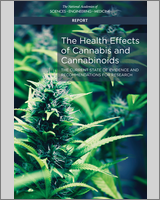From: 2, Cannabis

NCBI Bookshelf. A service of the National Library of Medicine, National Institutes of Health.
There are two endocannabinoids, 2-archidonoylglycerol (2-AG) and anandamide.
2-AG is generated by the enzymatic activity of a membrane-associated diacylglycerol lipase (DGL), which converts Sn2-arachidonic acid containing diacylglycerols into 2-AG (see Figure 2-2). Two isoforms of DGL, alpha and beta, have been identified. The alpha isoform generates 2-AG utilized during neuronal development and for synaptic communication between neurons, while the beta isoform may contribute to both brain development and inflammation. The activity of DGL-α is regulated by intracellular calcium, glutathione, and cellular localization, and via posttranslational modification. Once produced, 2-AG can act via both CB1 and CB2 receptors to exert a range of biological effects in central and peripheral cells.
2-AG is primarily degraded by monoacylglycerol lipase (MGL) into free arachidonic acid and glycerol. In the central nervous system (CNS), the free arachidonic acid generated by MGL-mediated hydrolysis of 2-AG may serve as a precursor for the generation of prostaglandins by cyclooxygenases. The activity of MGL can be regulated by posttranslational modification (e.g., sulfenylation). There is also evidence that 2-AG can be oxygenated by cyclooxygenase-2 to generate prostaglandin glycerols.
The formation of anandamide involves two steps (see Figure 2-3). The first consists of the transfer of arachidonic acid from phosphatidylcholine (PC) to phosphatidylethanolamine (PE). This reaction is catalyzed by the N-acyltransferase PLA2G4E and yields a diverse group of N-arachidonoyl-substituted PE species (NAPEs). The second step is the cleavage of NAPEs to produce anandamide and may be mediated by either NAPE-specific phospholipase D (NAPE-PLD) or alpha/ beta-hydrolase domain-4 (ABHD-4). PLA2G4E may represent the rate-limiting step for anandamide formation, though additional work is needed to confirm this possibility. After release into the extracellular milieu, anandamide is captured by neurons and glia through carrier-mediated transport and is subsequently hydrolyzed to arachidonic acid by fatty acid amide hydrolase (FAAH), a postsynaptic serine hydrolase expressed throughout the CNS. In microglia, anandamide might be also degraded by the lysosomal cysteine hydrolase, N-acylethanolamine acid amidase (NAAA).
One of the best-studied forms of endocannabinoid signaling occurs at CNS synapses. There are several unique features of endocannabinoid signaling relative to amino acid and peptide-based neurotransmitters. First, endocannabinoid signaling occurs in a retrograde direction, i.e., the signaling is initiated in postsynaptic neurons and acts upon presynaptic terminals. This is in stark contrast to traditional anterograde chemical neurotransmission, which is initiated at the axon terminal and conveys signals to postsynaptic neurons within a connected neuronal circuit or system. A second unique feature of this system is that, in contrast to classical neurotransmitters, endocannabinoids are not preformed and stored in vesicles pending release. In contrast, they are produced “on demand” upon stimulation of postsynaptic cells through a variety of signals.
The role of 2-AG in mediating endocannabinoid synaptic signaling has been well established during the past decade. Indeed, at excitatory synapses, all key components of 2-AG-mediated signaling (DGL-α, MGL, CB1 receptor) are ideally localized to facilitate retrograde control of neurotransmitter release. Specifically, DGL-α is found in postsynaptic spines while MGL and CB1 are located in axon terminals. The activity of DGL-α can be increased by stimulation of Gq-coupledneurotransmitter receptors (e.g., metabotropic glutamate receptors) or by a calcium influx. Once active, DGL-α generates 2-AG at the cell membrane, which travels in a retrograde direction to the presynaptic terminal to interact with CB1. The activation of CB1 by 2-AG results in a reduction in presynaptic release probability predominantly via Gi/o-dependent signal transduction cascades. This synaptic depression can last for seconds to minutes or longer, depending on the duration of receptor stimulation and the specific types of downstream signaling cascades initiated. After interacting with the receptor, 2-AG is hydrolyzed primarily by MGL located in the cytosol of the presynaptic axon terminal. MGL in astrocytes may also contribute to the termination of 2-AG-mediated synaptic signaling.
There is also evidence that anandamide can act as a retrograde modulator of neurotransmitter release in a manner similar to 2-AG, but with some distinct differences that are suggestive of a broader paracrine mode of action.
SOURCE: Piomelli, 2015.

Pathways of 2-AG formation and deactivation.

Pathways of anandamide formation and deactivation.
From: 2, Cannabis

NCBI Bookshelf. A service of the National Library of Medicine, National Institutes of Health.